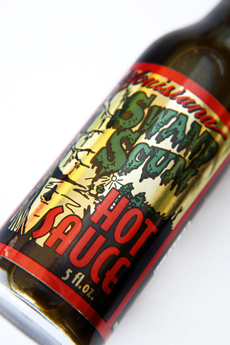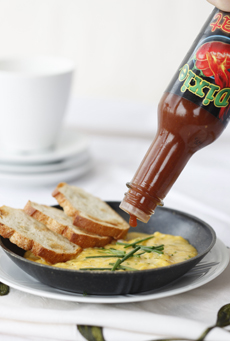
 Gourmet hot sauce garnishes scrambled eggs. All photography by Katharine Pollak | THE NIBBLE. Gourmet hot sauce garnishes scrambled eggs. All photography by Katharine Pollak | THE NIBBLE.
|
KAREN HOCHMAN is Editorial Director of THE NIBBLE.
|
|
August 2010
|
 |
Gourmet Hot Sauce
Artisans Who Love Hot Sauce Provide A Variety
Of Styles
CAPSULE REPORT: Hot sauce from the supermarket is a mass-produced product, made in huge batches and delivering the flavor of...heat. But in the hands of some artisans, hot sauces become complex condiments with layers of flavor. We taste quite a few hot sauces each year. Many are produced, like some supermarket brands, to deliver heat and not much else. Smaller doesn’t necessarily mean better. But in the case of the four sauces below, they are better indeed!
Gourmet Hot Sauce
A hot sauce is any condiment sauce made with chiles. All over the world, different cultures make their signature varieties—although no one outside the Americas had hot sauce before the 1400s, when traders from Portugal arrived with chiles, which are native to Central America. (See the history of chiles.)
When you taste any product, there should be layers of flavor—not a one-dimensional note. These artisan hot sauces deliver, with good fruit flavor. Fruit? Yes, the chile is a fruit. Not all fruits are sweet (avocado, a tree fruit just like peaches, is another example of a savory fruit).
To us, a “medium” heat is one that sizzles, but doesn’t dull the taste buds (and when we taste, we drink the sauce straight from the spoon). We’re not keen on “hot” hot sauces because, with the exception of Top Pick Of The Week Big Papi Hot Sauces, many are made with added chemical heat that exists to simply scorch.
A great hot sauce is a great stocking stuffer (and a five-ounce bottle slips easily into a stocking). In the case of the Dixie brand, the labels are even red and green. Click on the links for more information or to purchase the products.
- Dixie Delight Mild Hot Sauce. This red Florida hot sauce is the winner of the 2010 Silver Chile Award (second place) in Chile Pepper Magazine’s annual Fiery Food Challenge. Made from tomato concentrate, corn syrup, fresh cayenne pepper, garlic, vinegar and spices, it has a strong tomato taste with fruitiness and mild heat. It has the consistency of a light-style ketchup and we think of it as a very spicy ketchup. Calories: 5/teaspoon.
- Dixie Heat Smokin’ Hot Cayenne
Pepper Sauce. The sibling of Dixie Delight, above, this red hot sauce is made from tomato concentrate, corn syrup, fresh long hot peppers, onions, garlic, vinegar and spices. It ratchets up the heat over the Dixie Delight Mild Hot Sauce, and won the 2010 Gold Chile Award (first place) in Chile Pepper Magazine’s annual Fiery Food Challenge. It’s more of medium-hot than hot-hot. Calories: 5/teaspoon.
|
|

Something called Louisiana Swamp Scum can be very tasty. |
- Happy Dogs Hot Sauce. Made in St. Louis from aged red habanero peppers, cayenne peppers, fresh garlic and seasonings, this sauce is thin in consistency, but has lots of chile flavor and moderate heat. The pastiche of three dog photos on the label is a bit hokey, but sales put kibble on the table, so we won’t complain. Calories: 0/teaspoon.
-
Louisiana Swamp Scum. Humor aside, this green hot sauce is a winner—a Golden Chile Award in the 2002 Fiery Food Challenge, among others. Thin in style, it offers a delicious combination of chile, vinegar and smoke. It’s made of peppers, vinegar, salt, molasses and natural flavors and color. Calories: 5/teaspoon.
What To Do With Hot Sauce
These hot sauces are more than hot—they’re flavorful.
Thus, we can recommend them for practically any food or beverage where you’d like some heat.
- The traditional uses: Bloody Mary, burgers, eggs, ribs, fried foods, meat loaf, tacos and the like.
- Add heat to other sauces: Not just wing sauce but pan sauces (deglaze and add a shake of hot sauce) and salad dressings. Make a compound butter and use it on popcorn and vegetables.
- Add heat to other condiments: Create spicy ketchup, spicy mayo, spicy cocktail sauce and tartar sauce, spicy olive oil and spicy mango chutney.
- Season soup and chili: Instead of adding salt, shake some hot sauce into soup (not just the traditional black bean, chili, hot and sour soup and tortilla soup, but gazpacho and almost every meat-based or vegetarian soup except those with very delicate flavors.) Spice up Grandma’s chicken soup!
|
|

Shake hot sauce, not salt! |
Dave Pace, founder of Pace Foods, who began to manufacture hot sauce in Texas in 1947, would even shake hot sauce in his coffee. We haven’t tried that yet—but who would question Dave Pace? (Read more about him and the history of salsa and hot sauce.)
Go To The Article Index Above
|






